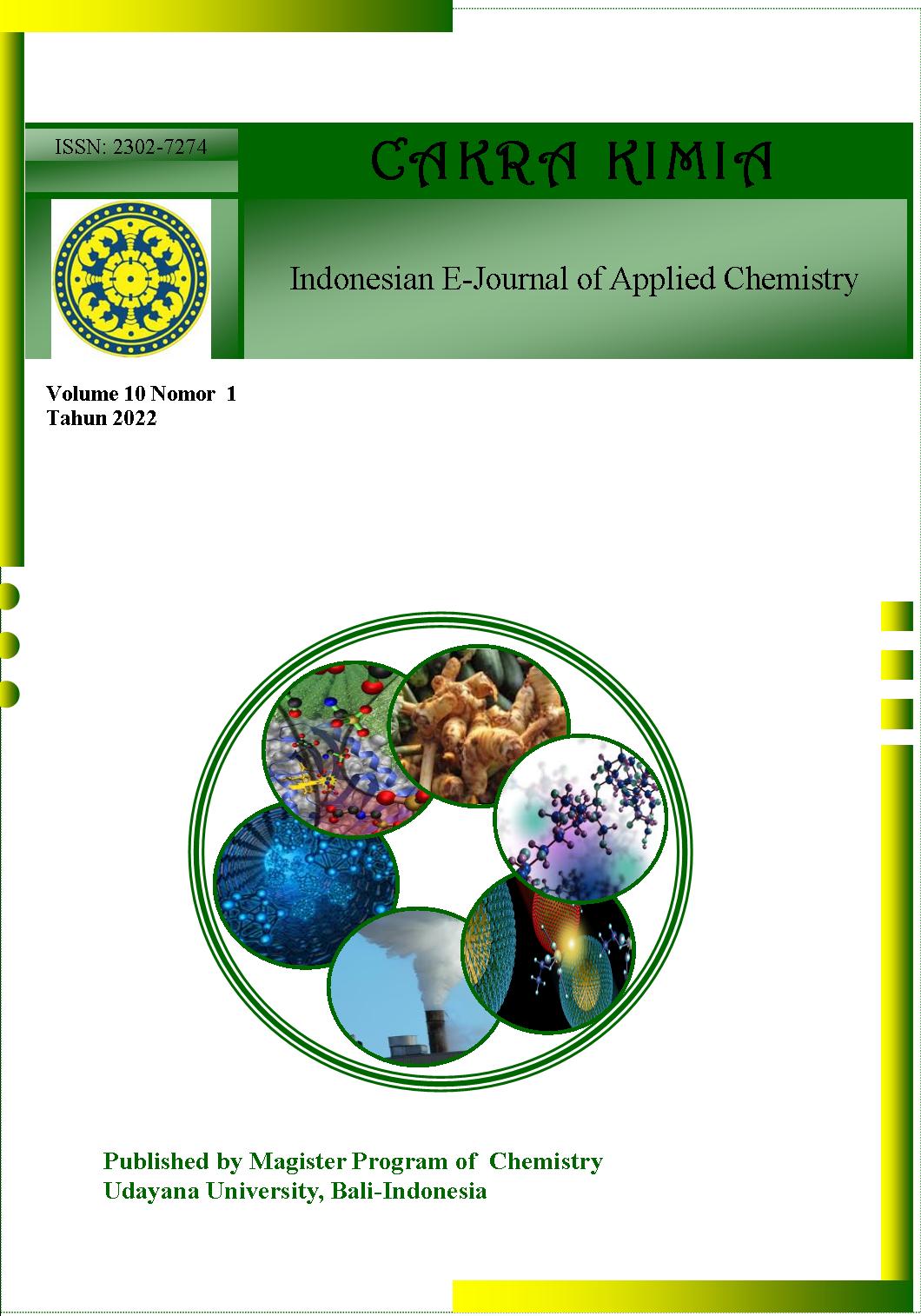PENGARUH PENAMBAHAN AGEN ANTIBAKTERI TiO2 DAN ZnO PADA FILM KOMPOSIT SELULOSA/POLI(VINIL ALKOHOL)
Abstract
ABSTRAK: Polimer alam merupakan salah satu keanekaragaman hayati yang melimpah di Indonesia. Selulosa adalah salah satu polimer alam yang dapat dimanfaatkan untuk keperluan medis, pembedahan, dan perawatan kesehatan. Modifikasi selulosa dengan menggunakan bahan organik-anorganik untuk meningkatkan sifat antibakteri material sangat perlu untuk dilakukan. Agen antibakteri berupa oksida logam semikonduktor banyak digunakan. Material oksida logam seperti TiO2 dan ZnO digunakan sebagai agen antibakteri karena ekonomis, aman, tidak beracun, stabil, dan mampu menyerap sinar ultraviolet (UV). Pada penelitian ini beberapa komposit akan disiapkan, yaitu selulosa/PVA, selulosa/PVA/TiO2 1%, selulosa/PVA/TiO2/ZnO 1%, dan selulosa/PVA/ZnO 1%. Karakteristik komposit dianalisis dengan Scanning Electron Microscope (SEM), dan X-Ray Diffraction (XRD). Aktivitas antibakteri komposit juga ditentukan dengan menghitung angka lempeng total (ALT). Senyawa oksida logam yang berperan sebagai agen antibakteri, mampu menghambat laju pertumbuhan bakteri. Hampir keseluruhan sampel film komposit memiliki efek penghambatan yang lebih baik terhadap bakteri Staphylococcus aureus (S. aureus) daripada Escherichia coli (E. coli).
ABSTRACT: Natural polymers are one of the abundant biodiversity in Indonesia. Cellulose is one of the natural polymers that can be applied for medical, surgical, and health care purposes. Modification of cellulose using organic-inorganic materials to enhance the antibacterial properties of material is very necessary. The antibacterial agents in the form of semiconductor metal oxides have been widely used. The metal oxide materials such as TiO2 and ZnO have been utilized as antibacterial agents due to economic, safe, non-toxic, stable, and able to absorb ultraviolet (UV) light. In this study, several composites would be prepared, e.g., cellulose/PVA, cellulose/PVA/TiO2 1%, cellulose/PVA/TiO2/ZnO 1%, and cellulose/PVA/ZnO 1%. Thus, the utilization of cellulose-based natural polymers can be increased and expanded, especially in the medical or health fields. The characteristic of composites was determined using Scanning Electron Microscope (SEM), and X-Ray Diffraction (XRD). The antibacterial activity of composite would be determined using total plate count (TPC). Metal oxide compounds as antibacterial agents were able to inhibit the growth rate of bacteria. Almost all composite films have a greater inhibitory effect on Staphylococcus aureus (S. aureus) than Escherichia coli (E. coli).
Downloads
References
[2] D. Trache, A. F. Tarchoun, M. Derradji, T. S. Hamidon, N. Masruchin, N. Brosse, Hussin, M.H,. "Nanocellulose: From Fundamentals to Advanced Applications," Frontiers in Chemistry, 8, 2020
[3] Y. Li, J. Tian, C. Yang, and B. Hsiao, 2018."Nanocomposite Film Containing Fibrous Cellulose Scaffold and Ag/TiO2 Nanoparticles and Its Antibacterial Activity," Polymers, vol. 10, p. 1052,
[4] K. L. T. Carrillo and T. Kobayashi, "Natural Material Source of Bagasse Cellulose and Their Application to Hydrogel Films," pp. 19-43, 2017.
[5] A. A. Septevani, D. Burhani, and S. Sudiyarmanto, "Pengaruh Proses Pemutihan Multi Tahap Serat Selulosa Dari Limbah Tandan Kosong Kelapa Sawit," Jurnal Kimia dan Kemasan, vol. 40, p. 71, 2018.
[6] G. Zhao, X. Lyu, J. Lee, X. Cui, and W.-N. Chen, "Biodegradable and transparent cellulose film prepared eco-friendly from durian rind for packaging application," Food Packaging and Shelf Life, vol. 21, p. 100345, 2019.
[7] Y. Wang, L. Zhang, J. Zhou, and A. Lu, "Flexible and Transparent Cellulose-Based Ionic Film as a Humidity Sensor," ACS Applied Materials & Interfaces, vol. 12, pp. 7631-7638, 2020.
[8] A. M. Babker, S. Sotnik, and V. Lyashenko, "Polymeric Materials in Medicine," Scholars Journal of Applied Medical Sciences, 2018.
[9] T. Poonsub, W. Chanikarn, I. Wirawan, S. Sunantha, and K. Chanin, "Effect of TiO2 and ZnO on Thin Film Properties of PET/PBS Blend for Food Packaging Applications," Energy Procedia, vol. 56, pp. 102-111, 2014.
[10] S. Ramesh, H. S. Kim, and J.-H. Kim, "Cellulose–Polyvinyl Alcohol–Nano-TiO2 Hybrid Nanocomposite: Thermal, Optical, and Antimicrobial Properties against Pathogenic Bacteria," Polymer-Plastics Technology and Engineering, vol. 57, pp. 669-681, 2017.
[11] M. Azizi-Lalabadi, A.-S. Mahmood, D. Baharak, E. Ali, and M. David Julian, "Nanocomposite films consisting of functional nanoparticles (TiO2 and ZnO) embedded in 4A-Zeolite and mixed polymer matrices (gelatin and polyvinyl alcohol)," Food Research International, vol. 137, p. 109716, 2020.
[12] M. Azizi-Lalabadi, A. Ehsani, B. Divband, and M. Alizadeh-Sani, "Antimicrobial activity of Titanium dioxide and Zinc oxide nanoparticles supported in 4A zeolite and evaluation the morphological characteristic," Scientific Reports, vol. 9, 2019.
[13] S. Acharya, Y. Hu, H. Moussa, and N. Abidi, "Preparation and characterization of transparent cellulose films using an improved cellulose dissolution process," Journal of Applied Polymer Science, 2017.
[14] N. Chiaoprakobkij, T. Suwanmajo, N. Sanchavanakit, and M. Phisalaphong, "Curcumin-Loaded Bacterial Cellulose/Alginate/Gelatin as A Multifunctional Biopolymer Composite Film," Molecules, vol. 25, p. 3800, 2020.
[15] W. M. Yusmamana and J. Gunlazuardi, "The Role of Citric Acid Modifiers Addition in The Preparation of TiO2 Nanoparticles with The Solvothermal Method," 2020.
[16] S. Wahyuningsih, A. H. Ramelan, R. M. I. Munifa, L. N. M. Z. Saputri, and U. Chasanah, "Synthesis of TiO2 nanorods from titania and titanyl sulfate produced from ilmenite dissolution by hydrothermal method," Journal of Physics: Conference Series, vol. 776, p. 012044, 2016.
[17] M. Amini and M. Ashrafi, "Photocatalytic degradation of some organic dyes under solar light irradiation using TiO2 and ZnO nanoparticles," ano. Chem. Res, vol. 1, pp. 79-86, 2016.
[18] T. Ennaert, B. Op de Beeck, J. Vanneste, A. T. Smit, W. J.J. Huijgen, A. Vanhulsel, et al., "The importance of pretreatment and feedstock purity in the reductive splitting of (ligno)cellulose by metal supported USY zeolite," The Royal Society of Chemistry 2015.
[19] P. Ganguly, C. Byrne, A. Breen, and S. C. Pillai, "Antimicrobial activity of photocatalysts: Fundamentals, mechanisms, kinetics and recent advances," Applied Catalysis B: Environmental, vol. 225, pp. 51-75, 2018.
[20] E. Mitchell. (2020, 12 Desember 2021). Gram Positive vs Gram Negative Bacteria and The Fight Against HAIs. Available: http://blog.eoscu.com/blog/gram-positive-vs-gram-positive
[21] Z. Breijyeh, J. Buthaina, and R. Karaman, "Resistance of Gram-Negative Bacteria to Current Antibacterial Agents and Approaches to Resolve It," Molecules, vol. 25, p. 1340, 2020.



 Petunjuk Penulisan
Petunjuk Penulisan
